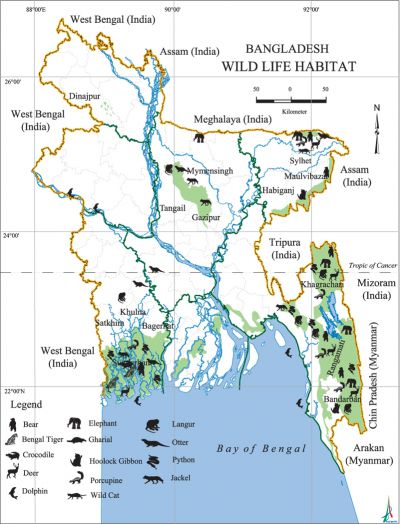Wildlife
Wildlife any vertebrate animal other than human being, domesticated animals and fishes, living in its natural habitat. Members of Amphibia, Reptilia, Aves, and Mammalia, their eggs or youngs are included in wildlife. Wild animals can live independently without the help or care of man. Not necessarily a wild animal has to live in forests or jungles; a wall lizard, a sparrow, a pigeon, a myna or a crow are all members of wild fauna.
In an area of about 1,47,570 sq km, Bangladesh has about 34 species of amphibians, 109 species of reptiles, 301 species of resident birds, 176 species of migratory birds, 143 species of ragrant birds, 30 species of birds went extirpated, 120 species of inland mammals, and 3 species of marine mammals.
This is undoubtedly extraordinary situation that such a great diversity still exists in an unusually overpopulated (140 million, with more than 1000 people per sq km) country with a very limited range of habitats.
-
Asian elephant
-
Deer (Sambar)
-
Wild cow
-
Mainland serow
-
Bear (Binturong)
-
Civet
-
Mangoose
-
Common otter
-
Leopard cat
-
Slow loris
-
Common peafowl (female)
-
Common lizard
-
Turtle Crocodile
-
Crocodile
-
Green frog
Bangladesh has lost more than a dozen of wild fauna during the last century. Of them the following could be mentioned: One horned-Rhinoceros, Rhinoceros unicornis; Javan Rhinoceros, R. sondaicus; Asiatic two-horned Rhinoceros, Didermoceros sumatrensis; Gaur, Bos gaurus; Banteng, B. banteng; Wild buffalo, Bubalus bubalis; Nilgai, Boselaphus tragocamelus; Swamp deer, Cervus duvaucelli; Wolf, Canis lupus; Pink-headed duck, Rhodonessa caryophyllacea; Common peafowl, Pavo cristatus; and Marsh crocodile, Crocodylus palustris (Redbook of Threatened Animals: IUCN-Bangladesh, 2000).
Since most wild animals largely depend upon the growth, extent and distribution of forests, decline of these natural habitats severely and adversely affect most inland and resident vertebrate fauna. In the last three decades, the stock of forest trees has declined in Bangladesh at an alarming rate. It is estimated that the forest cover has been reduced more than 50% since the 1970s. Estimates in 1990 revealed that Bangladesh had less than 0.02 ha of forestland per person - one of the lowest forest to population ratios in the world. Presently less that 8% of the country is under forest cover.
In Bangladesh amphibian fauna are represented by about 34 species of members of the order Anura. The orders Gymnophiona and Caudata have no representatives. For sometimes (1988-1993) the country used to export bullfrog legs (Hoplobatrachus tigerinus), but it is now banned.
The lizards, snakes, tortoises and turtles, crocodiles and gharial comprise the reptilian fauna of Bangladesh. A total of 154 species have been recorded. The marsh crocodile is no longer found in the wild in its natural habitats. The gharial (Gavialis gangeticus), few in number, occurs in a limited range in the river Padma.

Among the Testudines some including the River Terrapin (Batagur baska), Three-striped Roof Turtle (Kachuga dhongoka), Halud Pahari Kasim (Indotestudo elongata), Pahari Kasim (Asian Giant Tortoise, Manouria emys), and Bostami Kasim (Aspideretes nigricans) are critically endangered. The notable lizard species are the Flying lizard (Draco blanfordi) of the mixed evergreen forests, Monitor lizard (Varanus salvator), Bengal monitor (V. bengalensis), Yellow monitor (V. flavescens), Gecko (Gekko gecko), Garden lizard or Calotes (Calotes rouxii, C. jerdoni, C. versicolor), stripped skink (Mabuya dissimilis), and house lizards (Hemidactylus bowringii, H. brooki, H. flaviviridis, H. frenatus).
Less than half a dozen land snakes are highly poisonous. All sea snakes are known to be poisonous although they seldom bite. Important snakes of the country are Slender worm snake (Typhlops porrectus), Common sand boa (Eryx conica), Rock python (Python molurus), Reticulated python (Python reticulata), Common vine snake (Ahaetulla nasutus), Stripped keelback (Amphiesma stolata), Rat snake (Coluber mucosus, C. nigromarginatus), Common Trinket snake (Elaphe helena), Wolf snake (Lycodon aulicus, L. fasciatus, L. jara), Checkered Keelback (Xenochrophis piscator), Krait (Bungarus caeruleus, B. fasciatus, B. niger, B. lividus), Cobra (Naja kaouthia, N. naja), King cobra (Ophiophagus hannah), Pit vipers (Trimeresurus spp.), and Russell's viper (Vipera russellii).
Bangladesh has about 650 species of avifauna. The Sarus cane, Grus antigone (about 1.7 m tall) is considered as the largest bird of the country, although it is rarely seen in recent times. A few flowerpeckers and sunbirds, only about 7-8 cm in length, are perhaps the smallest. Degradation of forests and consequent ecological alterations obviously affected the composition of the avifauna. Birds associated with forests of some sort or with a swampy habitat have declined. The Pinheaded duck (Rhodonessa carryophyllacea), the Nuka or Comb duck (Sarkidiornis melanotos), the Common peafowl, the Burmese peafowl (P. muticus), Sarus crane, and the Bengal Florican (Eupodotis bengalensis) which were once more or less widely distributed, have now virtually disappeared from Bangladesh.
Most birds that migrate to Bangladesh come from the mountainous northern parts of the subcontinent. Some species come from different parts of Europe and from Siberia. There are certain species that stay in Bangladesh for a short period enroute to their destinations further South or Southeast. There are many species which stay here during autumn or spring.
The country has about 120 species of mammals. They range in size from tiny shrews and pipistrelle bats, which weigh only a few grams and measure a few centimetres, to elephants that stand over 3 metres at shoulder and can weigh over 4 metric tons. The largest mammal, the blue whale (Balaenoptera musculus) measuring about 30 metres in length and weighing up to 150 metric tons, often enters in Bangladesh waters.
Among the inland mammals, the order Chiroptera (bats) is the largest group. Some notable Chiropterans are Short-nosed fruit bat, False vampire, Indian pigmy pipistrelle, Asiatic lesser yellow bat, and Painted bat. Among the primates mention may be made about the Slow loris, Assamese macaque, Rhesus macaque, Hanuman langur, Capped monkey, and Hoolock gibbon. Order Carnivora is represented by 27 species. The notable ones are Jackal, Indian wild dog, Jungle cat, Asiatic golden cat, Clouded leopard, Royal Bengal tiger, Marbled cat, Fishing cat, Common Mongoose, Oriental small-clawed otter, Common otter, Sun bear, Himalayan black bear, and several species of civets. The Asian elephant is now distributed only in the forests of Chittagong and Cox's Bazar areas.
Artiodactyla is represented by one species of wild boar (Sus scrofa), three species of deer (Spotted deer/Sambar, Barking deer, and Indian Muntjac), and one species of serow. The three species of pangolin (order Pholidota) are-Scaly anteater (Manis crassicaudata), Malayan pangolin (M. javanica), and Chinese pangolin (M. pentadactyla). These are rarely seen and occur in the forests of Sylhet, Chittagong, Chittagong Hill Tracts, Comilla, and Mymensingh.
At least 21 species of Rodentia occur in Bangladesh. Among these some members of Muridae are widely distributed. The notable species are - House rat (Rattus rattus), Bram rat (R. norvegicus), house mouse (Mus musculus), and Bandicoot rat (Bandicota indica). The squirrels are represented by eight species; of these, the Pallas's squirrel, Orange-bellied Himalayan squirrel, Common giant flying squirrel, and Malayan giant squirrel are notable. Only two species of porcupines occur in Bangladesh. These are - Asiatic brush-tailed porcupine (Atherurus macrourus) and Indian porcupine (Hystrix indica). The Hispis hare or Assam rabbit and Rufous-tail hare represent the order Lagomorpha. [SM Humayun Kabir]
Acts, regulations and conventions relating to wildlife The Indian Forest Act, 1927 does not have any provision for wildlife management. It however, includes wild animals and skins, tusks, horns, bones, silk, cocoon, honey, beewax, etc in the definition of forest products.
During the British period there were a number of special acts/rules addressing the need for protecting wild birds and other animals as appropriate or to safeguard a specific species. These include: (a) Act for the Preservation of Wild Elephants, 1879; (b) The Wild Birds and Animals Protection Act, 1912; and (c) The Bengal Rhinoceros Preservation Act, 1932.
Besides these enactments, the Indian Forest Act, 1927 and the 1959 Ordinance provide provision conferring powers to the Government to regulate hunting, shooting and fishing within forests in which these legislations were applicable. Subsequently, the Government framed two separate sets of rules in 1959 to regulate these activities in public and private forests. Both the Rules classify the forests as:
Class A Forests in which all hunting, shooting, trapping or fishing were prohibited to prevent the extinction of any species or to form a sanctuary for game or for other purposes unless it is considered that a species is increasing to an undue extent causing threat to other resources.
Class B Forest in which hunting, shooting, trapping or fishing were permissible only by such persons as are privileged under the rule or under a permit in accordance with these rules.
The above legislations were not of much use in preserving the wildlife. As a consequence the Government of Bangladesh promulgated the Bangladesh Wildlife (Preservations) Order, 1973 as Presidential Order No.23 of 1973, which was enacted as Bangladesh Wildlife (Preservation) Act, 1973. The 1973 Act was amended, elaborated and reenacted as Bangladesh Wildlife (Preservation) (Amendment) Act, 1974. The amendment Act has 48 sections and three schedules. It provides for the constitution of Bangladesh Wildlife Advisory Board, Sanctuaries, National Parks, and Game Reserves; penalties and punishments for offenses; import and export of wild animals; set up of mobile court; duties and responsibilities of government officers; and rules and regulations to be made under this law. It also repealed the three laws of 1879, 1912 and 1932. The schedules provide a list of animals which can be hunted on permit; indicate the animals, trophies and meat, for the possession, transfer and trade of which a certificate of lawful possession is needed, and list the protected animals which shall not be hunted, killed or captured.
The First Schedule includes 3 species of amphibians, 3 reptiles, 27 birds and 3 mammals. It also includes the crabs. Animals that are listed under this schedule are open to shooting and may be hunted on an ordinary hunting permit. The Part II of the First Schedule specifies a number of reptiles, birds and mammals which need a special permit for hunting, e.g. increase of these animals if threatens the balance of nature of a particular locality or becomes a threat to public life (as in cases of man-eating tiger, rogue elephants, etc). The Second Schedule gives a list of wild animals whose trophies, meat or skin cannot be possessed without a lawful certificate. The Third Schedule includes 18 reptiles, 461 birds, and 67 mammals which are protected and cannot be hunted, killed or captured. Under this schedule the killing of all game animals have been made restricted when they are pregnant, or when in a condition that indicates they are suckling or feeding the young, or when accompanied by their immature offspring. This schedule also restricts the killing of all females as per Part II of the First Schedule except when declared as in case of a man-eating tigress, rogue elephant, etc.
The 1974 Act does not specify its relation with the provisions of 1927 Act and the rules made thereunder. It does not repeal the relevant provisions of the 1927 Act. However, it may be presumed that the 1974 Act as a parent law, has superseded the provisions and rules in or made under the 1927 Act. The 1974 Act is not an all-encompassing legislation. It is not sufficiently comprehensive and does not cover several important aspects. Worse still, the provisions included have not been properly implemented in the absence of adequate staff, facilities and funds. The Act needs an immediate revision.
There are a large number of laws and rules of general nature which have a strong bearing on forest resources and forest administration, and they have their origin much before the formation of Bangladesh. Some of the important ones are: Penal Code, 1860 (Central Act No. XLV of 1860); Cattle Trespass Act, 1871 (Central Act No. I of 1871); Evidence Act, 1871 (Central Act No. I of 1872); Contract Act, 1872; Limitation Act, 1877 (Central Act XV of 1877); Land Acquisition Act, 1894 (Central Act No. 1 of 1894); Criminal Procedure Code, 1898 (Central Act No. V of 1898); Civil Procedure Code, 1908 (Central Act No. V of 1908); Registration Act, 1908; Sale of Goods Act, 1930; and East Bengal Government Land (Recovery and Possession) and Building Act, 1952.
International Conventions, Treaties and Protocols (ICTPs) Bangladesh is a signatory to some international conventions, treaties and protocols which have bearing on forests and forest resources. Some of these have not been ratified, nevertheless, it is obliged to refrain from acts which would defeat the object and purpose of the treaty once it has been signed. These are:
Convention on International Trade in Endangered Species of Wild Fauna and flora (CITES; adopted on 3 March 1973 at Washington DC, USA, entered into force globally on 1 July 1975; Bangladesh signed on 20 November 1981). The purpose is to protect certain threatened species from over-exploitation by means of a system of import and export control.
Bangladesh is a contracting party to the Convention on Wetlands of International Importance, especially Waterfowl Habitats (Ramsar Convention), adopted in 1971.
International Convention on Oil Pollution Preparedness, Response and Cooperation; adopted on 30 November 1990 in London, UK; Bangladesh signed on the same data. It has not yet entered globally.
International Convention to Combat Desertification; adopted on 17 June 1994 at Paris, France. Bangladesh signed it on 21 June 1994. It has not yet entered globally.
Convention concerning the Protection of the World Cultural and Natural Heritage, was signed on 3 November 1983. The purpose is to establish an effective system of collective protection of the cultural and natural heritage of outstanding universal value, organised on a permanent basis and in accordance with modern scientific methods.
International Plant Protection Convention was signed on 1 September 1978. The objective is to maintain and increase international cooperation in controlling pests and diseases of plants and plant products, and in preventing their introduction and spread across national boundaries.
Plant Protection Agreement for the Asia and Pacific Regions signed on 4 December 1974. The aim is to prevent the introduction into and spread within the region of destructive plant diseases and pests.
Treaty Banning Nuclear Weapon Tests in the Atmosphere, in Outer Space and under Water; adopted on 5 August 1963 at Moscow; globally entered on 10 September 1963. Bangladesh signed it on 13 March 1985.
Bangladesh has signed the United Nations Framework Convention on Climate Change, New York (adopted on 9 May 1992; globally entered into force in March 1995; Bangladesh signed on 6 June 1992).
Recently Bangladesh has also signed Convention on Biological Diversity, Rio de Janeiro; adopted on 5 June 1992 at Rio de Janeiro, Brazil; globally entered into force on 29 December 1993. Bangladesh has also signed the convention at the Earth Summit on 5 June 1992. However, the country needs technical and institutional assistance to satisfy the conventions. [Md Anwarul Islam]
See also bat; bird; fauna; frog and toad; lizard; mammal; reptile; snake.














